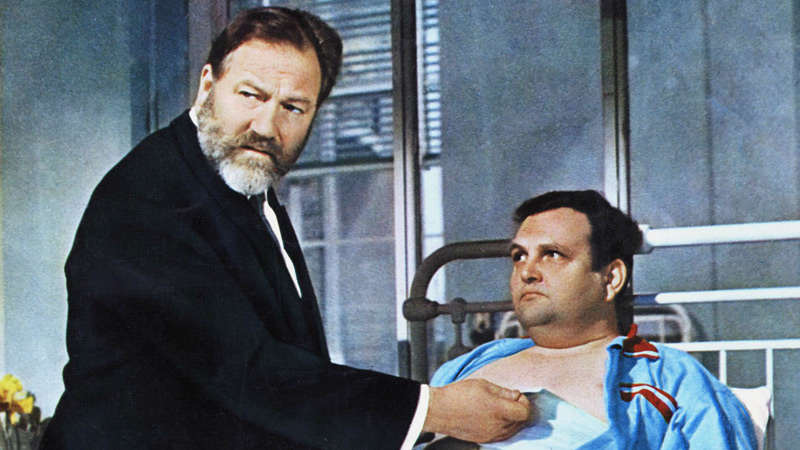
In lockdown I’ve been reading a lot of fiction. In an attempt to make it work-relevant fiction, I ordered a set of Richard Gordon's novels, including his most famous: Doctor in the House (1952).
Gordon was an English surgeon and anaesthetists who wrote a long series of comic novels on medical themes. Beginning with Doctor in the House, the books were set in St Swithin’s, a fictional London hospital, and follow the capers and exploits of a young medical student turned trainee who shared a name with the author in the books, but was re-christened Simon Sparrow in the films. The film version of Doctor in the House was released in 1954 and starred Dirk Bogarde as Sparrow and James Robertson Justice as the fearsome teaching hospital surgeon Spratt. A dictatorial demagogue, he strode down hospital corridors with a team of frightened trainees hurrying along behind him. In one iconic scene, Spratt stands at a patients’ bedside firing questions at a gaggle of medical students, one of whom has just examined the hapless and prone sufferer and found a lump.
‘Is it kidney? Is it spleen? Is it liver? Is it dangerous?’ barks Spratt, before drawing a long incision line on the patient’s abdomen, then turning to the by-now highly alarmed patient to say, ‘Now don’t worry, this is nothing whatever to do with you’.[1]

The fictional Gordon initially aspires to become a surgeon himself, but in the series’ third novel Doctor at Large (1954) he leaves his first job as St Swithin’s Junior Casualty House Surgeon to assist a GP in the midlands. All the books trade in surgical stereotypes and Gordon relies on familiar caricatures for much of his humour. When the fictional Gordon is appointed to his first surgical job he is one of two men in the position. They share a keenness for operating, ‘Both of us had the same enthusiasm for the knife as the Committee of Public Safety for the guillotine’.[2] And both were anxious to attain the lofty heights of the surgical career, even if, ‘The casualty-room at St Swithin’s was not likely to fire in any young man the inspiration to be a second Louis Pasteur or Astley Cooper.’[3]
However, his colleague, Bingham, is a very different kind of man and a very different kind of surgeon to the one Gordon is attempting to become. Indeed, the caricature that dominates the books is that of the detached, disinterested surgeon. Surgical practitioners in Gordon’s novels – at least the ones that seem to succeed in the profession – display varying degrees of indifference to the patients they treat. Bingham had ‘the true surgeon’s mentality’ for ‘it never occurred to him that interesting signs and symptoms were attached to human beings’.[4] He gleefully refers to maladies rather than people – ‘“I’ve got a couple of septic fingers, a lipoma, and four circs. Lined up for minor ops. already.” He rubbed his hands, as if contemplating a good dinner’[5] – and seems to feel actual joy at other people’s suffering, ‘There’s a kid with a smashing ductus, too. Murmur as loud as a bus. Could hardly take my bally stethoscope away’.[6]
Gordon’s novels were, of course, comedies and played serious subjects for laughs. It is unlikely that he – a health professional himself – believed that real surgeons in the 1950s were as disinterested in their patients as some of his characters might make you believe, but the success of these novels and the ease with which he reaches for such stereotypes suggests that these ideas circulated widely in post-war British thought.
After all, these stereotypes must have come from somewhere. Revealing or demonstrating the ‘relative throw – the weight or significance’ of culture on ordinary people in the past is an unresolved challenge to the cultural historian.[7] While some non-surgeons today might not recognise or remember Sir Lancelot, Doctor in the House was the most popular box office film of 1954 in Great Britain, seen by one-third of the national population – or 15,500,000 people. The many sequels were viewed by yet more millions and there is increasing recognition of the power of fictional, filmic, and televisual representations to shape professional identities and surgical self-image.
For me, several questions remain and deserve further study. Why has the surgical stereotype that appears in Doctor in the House proven so resilient, where did it come from, and did Sir Lancelot Spratt and Bingham resemble the surgeons who walked the hospital wards in post-war Britain? These questions are important to answer, if only because the caricature of the emotionally indifferent surgeon continues to dominate public perceptions of the profession - alienating people from their healthcare professionals and deterring some medical students and junior doctors from pursuing the specialty.
[1] John Spencer, ‘Some Activity But Still Not Much Action on Patient and Public Engagement’, Medical Education, 50 (2016), 3-23, 3.
[2] Richard Gordon, Doctor at Large, (Penguin: Harmondsworth, 1975), 15.
[3] Ibid, 13.
[4] Ibid.
[5] Ibid, 12.
[6] Ibid, 13.
[7] Lesley Scanlon, ‘White Coats, Handmaidens and Warrior Chiefs: The Role of Filmic Representations in Becoming a Professional’, in Lesley Scanlon (ed.), “Becoming” a Professional: An Interdisciplinary Analysis of Professional Learning, (Springer, 2011), 109.